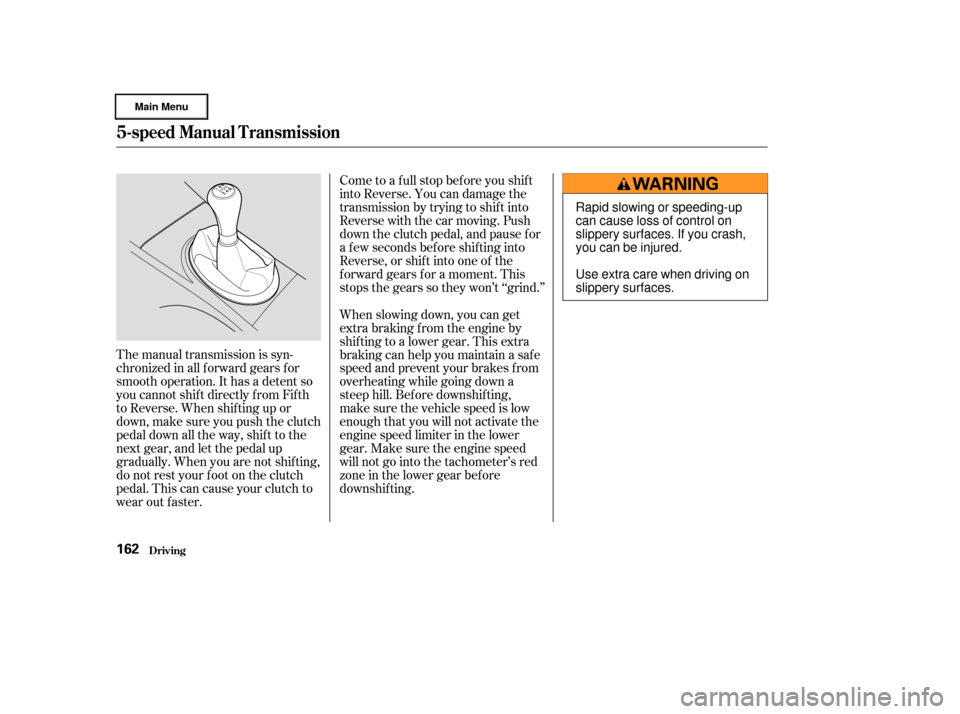Page 115 of 317
Air conditioning also removes mois-
ture from the air as it operates. You
can use it to def og the windows
quickly in cool or damp weather.
Used in combination with the heater,
it also makes the interior warm and
dry.
Air conditioning places an extra load
on the engine. Watch the engine
coolant temperature gauge (see page) when using the A/C in heavy
traf f ic or driving up long hills. If the
reading reaches near the red mark,
turn of f the air conditioning until the
gauge reads normally. 71
Heating and Cooling (Automatic System)
Comf ort and Convenience Feat ures112
MODE CONTROL DIAL
TEMPERATURE
CONTROL DIAL
FAN CONTROL DIAL RECIRCULATION BUTTON AIR CONDITIONING BUTTONECON BUTTON
Page 116 of 317

This button controls the source of
the air going into the system. When
the indicator in this button is lit, air
from the car’s interior is sent
through the system again (Recircula-
tion mode). When the indicator is off,
air is brought in f rom outside the car
(Fresh Air mode).
Use Recirculation mode to heat or
cool the interior more quickly, or to
keep out smoke and dust. Leaving
the system in the Recirculation mode
with the A/C off can cause the
windows to f og up. Switch to Fresh
Air mode as soon as the interior
reaches a comf ortable temperature
or the outside smoky, dusty con-
dition clears.You can manually select the f an
speed by turning the f an speed
control dial. Turning this dial
clockwise increases the f an speed,
which increases air flow.
When the dial is set to AUTO, the
system controls the f an speed
automatically.
When the f an speed control dial is
of f , the Auto Idle Stop works under
certain conditions (see pages
and ). Use the MODE control dial to select
the vents the air flows from. Some
air will f low f rom the dashboard
corner vents in all modes.
In AUTO mode, the system controls
the air f low direction automatically
between the dashboard vents and
the f loor vents.
163 171
CONT INUED
Heating and Cooling (Automatic System)
Comf ort and Convenience Feat ures
Recirculat ion But t on
Fan SpeedMode Cont rol Dial
113
Page 117 of 317
The main air flow comes out
of the dashboard vents.
The main air f low is divided
between the dashboard vents and
the f loor vents.
Heating and Cooling (Automatic System)
Comf ort and Convenience Feat ures114
Page 118 of 317
The main air flow comes
f rom the f loor vents.
When you select , the system
automatically switches to Fresh Air
mode.
The main air f low is divided
between the f loor vents and de-
froster vents at the base of the wind-
shield.
When you select , the system
automatically switches to Fresh Air
mode, turns on the A/C, and turns
of f the ECON mode.
CONT INUED
Heating and Cooling (Automatic System)
Comf ort and Convenience Feat ures115
Page 119 of 317
�™�™
The directs the main air flow
to the windshield for faster
def rosting or def ogging. It also
overrides any MODE selection you
may have made. When you select
, the A/C turns on
automatically and the system selects
Fresh Air mode and turns of f the
ECON mode. To def rost or def og
more quickly, turn the temperature
control dial to 82°F 86°F (28°C
30°C). Select and set the f an
speed to high. To turn of f def rost or
defog, turn the mode control dial to
another mode. When you switch to
another mode f rom , the A/C
stayson.PresstheA/Cbuttonto
turn it off.
If there is actual frost on the win-
dows, f irst select the Recirculation
mode. If the windows are f ogged,
select the Fresh Air mode. Warmed
air will then flow from the wind-
shield and side def roster vents.
Heating and Cooling (Automatic System)
Comf ort and Convenience Feat ures116
MODE CONTROL
DIAL
TEMPERATURE
CONTROL DIALFAN CONTROL
DIAL RECIRCULATION
BUTTON
AIR CONDITIONING BUTTON
ECON BUTTON
Page 120 of 317
When you select or ,
the Auto Idle Stop f unction will not
activate.To regulate the interior temperature,
the system has two sensors. A sun-
light sensor is located in the top of
the dashboard and a temperature
sensor is next to the steering column.
Do not cover the sensors or spill any
liquidonthem.
Heating and Cooling (Automatic System)
Comf ort and Convenience Feat ures
Sunlight Sensor/T emperature
Sensor
117
SULIGHT SENSOR TEMPERATURE SENSOR
Page 165 of 317

Come to a full stop before you shift
into Reverse. You can damage the
transmission by trying to shif t into
Reverse with the car moving. Push
down the clutch pedal, and pause f or
a f ew seconds bef ore shif ting into
Reverse, or shif t into one of the
f orward gears f or a moment. This
stops the gears so they won’t ‘‘grind.’’
The manual transmission is syn-
chronizedinallforwardgearsfor
smooth operation. It has a detent so
you cannot shift directly from Fifth
to Reverse. When shif ting up or
down,makesureyoupushtheclutch
pedal down all the way, shift to the
next gear, and let the pedal up
gradually. When you are not shif ting,
do not rest your f oot on the clutch
pedal. This can cause your clutch to
wear out faster. When slowing down, you can get
extra braking f rom the engine by
shifting to a lower gear. This extra
braking can help you maintain a safe
speed and prevent your brakes f rom
overheating while going down a
steep hill. Bef ore downshif ting,
make sure the vehicle speed is low
enough that you will not activate the
engine speed limiter in the lower
gear. Make sure the engine speed
will not go into the tachometer’s red
zone in the lower gear bef ore
downshif ting.
5-speed Manual T ransmission
Driving162
Rapid slowing or speeding-up
can cause loss of control on
slippery surfaces. If you crash,
you can be injured.
Use extra care when driving on
slippery surfaces.
Page 225 of 317
To replace it:Open the glove box. Remove the
hooks on the side panels by pulling
out on the tabs. Pivot the glove
box out of the way.
The dust and pollen f ilter is located
behind the glove box.
Remove the dust and pollen f ilter
cover by pushing in on the lock tab,
then pulling the cover toward you.
The dust and pollen f ilter removes
pollen and dust that is brought in
f rom the outside through the heating
andcoolingsystem.
This f ilter should be replaced every
30,000 miles (48,000 km) under
normal conditions. It should be
replaced every 15,000 miles (24,000
km) if you drive primarily in urban
areas that have high concentrations
of soot in the air f rom industry and
diesel-powered vehicles. Replace it
more of ten if air f low f rom the
heating and cooling system becomes
less than usual.
1.2.
Dust and Pollen Filter
Maint enance
Replacement
222
HOOKS
COVER
TAB